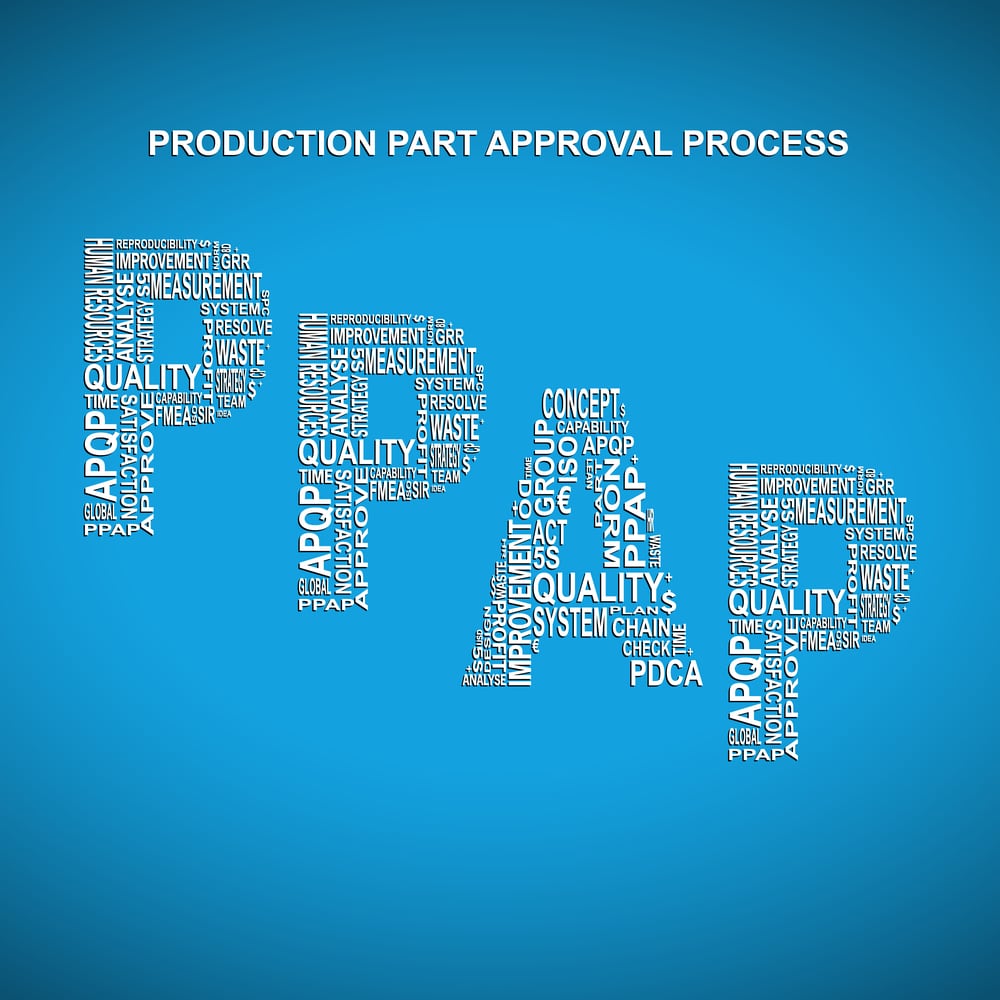PPAP - Production Part Approval Process
Unless otherwise agreed to, a validation for each part is submitted to the customer with an "AIAG PPAP Level III" standard. This approval process has been adopted as our standard to ensure a quality product is provided to our customers. While it is primarily used in the automotive supply chain, we have adapted it to use across the board for all of our customers regardless of their market because it has some of the most stringent requirements and controls. An approved PPAP demonstrates that all customer engineering design record and specification requirements are properly understood. The process has the potential to produce product consistently meeting these requirements, and future production runs can be maintained at the quoted production rate.
The PPAP package documentation is closely related to the Advanced Product Quality Planning process (APQP) used during the design and development of new vehicles and component systems to reduce the risk of unexpected failure due to errors in design and manufacture. The PPAP manual is published by the Automotive Industry Action Group (AIAG) and specifies generic requirements for obtaining PPAP approvals. Additional customer-specific requirements may be imposed by particular clients and incorporated in the purchasing contracts.

A PPAP (Production Part Approval Process) consists of 18-elements, modified based on customer-specific requirements or product specifications. These include:
A copy of the drawing. If the customer is design responsible, this is a copy of the customer drawing sent together with the Purchase Order (PO). If the supplier is design responsible, this is a released drawing in the supplier's release system.
A document that shows the detailed description of the change. Usually, this document is called "Engineering Change Notice," but it may be covered by the customer PO or any other engineering authorization.
This approval is usually the Engineering trial with production parts performed at the customer plant. A "temporary deviation" usually is required to send parts to the customer before PPAP. Customers may require other "Engineering Approvals."
A copy of the Design Failure Mode and Effect Analysis (DFMEA), reviewed and signed-off by supplier and customer. If the customer is design responsible, usually the customer may not share this document with the supplier. However, the list of all critical or high impact product characteristics should be shared with the supplier to be addressed on the PFMEA and Control Plan.
A copy of the Process Flow, indicating all steps and sequences in the fabrication process, including incoming components.
A copy of the Process Failure Mode and Effect Analysis (PFMEA), reviewed and signed-off by supplier and customer. The PFMEA follows the Process Flow steps and indicates "what could go wrong" during each component's fabrication and assembly.
A copy of the Control Plan, reviewed and signed-off by supplier and customer. The Control Plan follows the PFMEA steps and provides more details on how the "potential issues" are checked in the incoming quality, assembly process, or during inspections of finished products.
MSA usually contains the Gage R&R for the critical or high impact characteristics and a confirmation that gauges used to measure these characteristics are calibrated.
A list of every dimension noted on the ballooned drawing. This list shows the product characteristic, specifications, measurement results, and the assessment showing if this dimension is "ok" or "not ok." Usually, a minimum of 6 pieces is reported per product/process combination.
A summary of every test performed on the part. This summary is usually in the form of DVP&R (Design Verification Plan and Report), which lists each individual test when it was performed, the specification, results, and the assessment pass/fail. If there is an Engineering Specification, it is usually noted on the print. The DVP&R shall be reviewed and signed off by both customer and supplier engineering groups. The quality engineer will look for a customer signature on this document. In addition, this section lists all material certifications (steel, plastics, plating, etc.), as specified on the print. The material certification shall show compliance to the specific call on the print.
Usually, this section shows all Statistical Process Control charts affecting the most critical characteristics. The intent is to demonstrate that critical processes have stable variability, running near the intended nominal value.
Copy of all laboratory certifications (e.g., A2LA, ISO 17025) of the laboratories that performed the tests reported in section 10.
A copy of the AAI (Appearance Approval Inspection) form signed by the customer. Applicable for components affecting appearance only.
A sample from the same lot of initial production run. The PPAP package usually shows a picture of the sample and where it is kept (customer or supplier).
A sample signed off by customer and supplier, usually used to train operators on subjective inspections such as visual or for noise.
When there are special tools for checking parts, this section shows a picture of the tool and calibration records, including a dimensional report of the tool.
Each customer may have specific requirements to be included in the PPAP package. It is a good practice to ask the customer for PPAP expectations before even quoting for a job. North American Auto Makers OEM (Original Equipment Manufacturer) requirements are listed on http://www.iaob.org website.
This is the form that summarizes the whole PPAP package. This form shows the reason for submission (design change, annual revalidation, etc.) and the level of documents submitted to the customer. A section asks for "results meeting all drawing and specification requirements: yes/no" refers to the whole package. If there are any deviations, the supplier should note on the warrant or inform that PPAP cannot be submitted.
